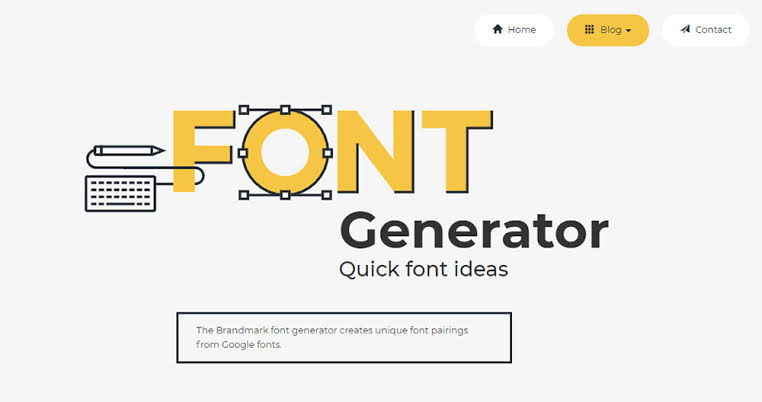In the realm of web design, typography serves as a powerful tool for establishing brand identity, enhancing readability, and creating visual impact.
\While web browsers traditionally support a limited set of fonts, using custom fonts can significantly elevate the aesthetic appeal and user experience of a website.
Web font generators offer a practical solution to integrate custom fonts seamlessly into web projects, converting them into formats compatible with modern web standards.
This article explores the process of using a web font generator, from selecting and uploading fonts to integrating them into your website’s CSS, along with tips for optimizing performance and ensuring cross-browser compatibility.
- Choosing the Right Web Font Generator
- Uploading and Selecting Fonts
- Customizing Font Settings
- Generating and Downloading Web Font Packages
- Integrating Web Fonts into CSS
- Testing and Optimization
- Best Practices for Using Web Fonts
- Conclusion
- People May Ask
- Are web font generators free to use?
- Can I use any font with a web font generator?
- Do web fonts affect website loading speed?
- How do I ensure web fonts display consistently across different browsers?
- Can I use custom web fonts with content management systems (CMS) like WordPress?
Choosing the Right Web Font Generator
The first step in utilizing a web font generator is selecting the right tool for your needs. Popular web font generators like Google Fonts, Font Squirrel, and Fontspring offer user-friendly interfaces and comprehensive font libraries.
Consider factors such as format compatibility (WOFF, WOFF2), customization options, and whether the generator supports font subset creation to optimize loading times.
Evaluate the generator’s ease of use and accessibility of its fonts, ensuring they align with your project’s design requirements and licensing restrictions.
Uploading and Selecting Fonts
Once you’ve chosen a web font generator, the next step is uploading your desired font files. Most generators accept standard font formats such as TTF (TrueType), OTF (OpenType), and SVG (Scalable Vector Graphics).
Upload your fonts through the generator’s interface, ensuring you have the appropriate licenses for commercial use if applicable.
Some generators allow you to select specific font weights, styles, and character subsets, enabling customization tailored to your website’s typography needs.
Customizing Font Settings
After uploading fonts, web font generators typically offer customization options to refine how fonts appear on your website.
Adjust parameters such as font weight, style variants (italic, bold), and character sets to optimize performance and ensure compatibility across different devices and browsers.
Font subset creation allows you to include only necessary characters, reducing file sizes and improving loading times.
Take advantage of these customization features to achieve a cohesive and visually appealing typography design.
Generating and Downloading Web Font Packages
Once customization is complete, the web font generator compiles your selected fonts into web-compatible formats such as WOFF (Web Open Font Format) and WOFF2.
These formats are optimized for web use, offering efficient compression and broad browser support. After generating the fonts, download the web font package containing the necessary font files and CSS snippets.
These snippets include @font-face declarations and font-family definitions that simplify integration into your website’s stylesheet.
Integrating Web Fonts into CSS
Integrating web fonts into your CSS stylesheet is a straightforward process facilitated by the CSS snippets provided by the web font generator.
Copy and paste the @font-face declarations and font-family rules into your stylesheet, ensuring they are strategically placed to apply custom fonts consistently throughout your website.
Test font rendering across different pages and screen sizes using browser developer tools to verify integration and readability.
Testing and Optimization
After integrating web fonts, thorough testing is essential to ensure optimal performance and visual consistency across various devices and browsers.
Use tools like Google PageSpeed Insights or GTmetrix to analyze loading times and identify opportunities for optimization.
Consider implementing font loading strategies such as asynchronous loading, font preloading, and fallback font stacks to enhance user experience and mitigate potential issues.
Best Practices for Using Web Fonts
Adhere to best practices when using web fonts to maximize performance and usability:
- Limit the number of font styles and weights to reduce file sizes and improve loading times.
- Use system fonts or fallbacks for critical text elements to ensure readability in case web fonts fail to load.
- Monitor web font performance using analytics tools to assess their impact on page speed and user engagement, making adjustments as needed.
Conclusion
Web font generators empower web designers and developers to enhance typography and create visually compelling websites with custom fonts.
By following a structured approach—from selecting a generator and uploading fonts to customization, integration, and optimization—designers can achieve distinctive typography designs that reflect brand identity and improve user experience.
As the landscape of web design continues to evolve, leveraging web font generators ensures that websites not only look aesthetically pleasing but also perform optimally across diverse digital platforms.
Embrace the creative potential of web fonts to elevate your web projects and captivate audiences with engaging and readable typography.
People May Ask
Are web font generators free to use?
Many web font generators offer basic services for free, while some may require subscriptions or offer premium features for advanced customization options and access to larger font libraries.
Can I use any font with a web font generator?
Web font generators support a wide range of font formats, but not all fonts are suitable for web use due to licensing restrictions or technical compatibility issues. Always check font licenses and usage terms before uploading them to a web font generator.
Do web fonts affect website loading speed?
Web fonts can impact loading speed, especially if multiple fonts or large font files are used. Optimize performance by selecting appropriate font formats, creating font subsets, and implementing efficient loading strategies.
How do I ensure web fonts display consistently across different browsers?
Ensure cross-browser compatibility by testing web fonts on popular browsers and devices during the design and development stages. Use vendor-specific CSS prefixes and fallback font stacks as needed to achieve consistent rendering.
Can I use custom web fonts with content management systems (CMS) like WordPress?
Yes, most CMS platforms support custom web fonts integrated through CSS. Use the built-in CSS editors or theme customization options to implement web fonts generated from web font generators into your CMS-based website.
Click here to learn more.
- Pokimane Shares Traumatic Phone Number Leak Story on Sweet n Sour Podcast | Must-Read!
- How Griselda Blanco’s Sons Died: The True Story Behind Their Tragic Deaths
- Money6x.com: 50+ Ways to Earn Money from Home
- Asmongold’s New Relationship with Kaise Criticized by Viewers as “Weird”
- Pokemon Go Spotlight Hour October 2024: Full Schedule and Shiny Availability

I am a passionate technology and business enthusiast, constantly exploring the intersection where innovation meets entrepreneurship. With a keen eye for emerging trends and a deep understanding of market dynamics, I provide insightful analysis and commentary on the latest advancements shaping the tech industry.
